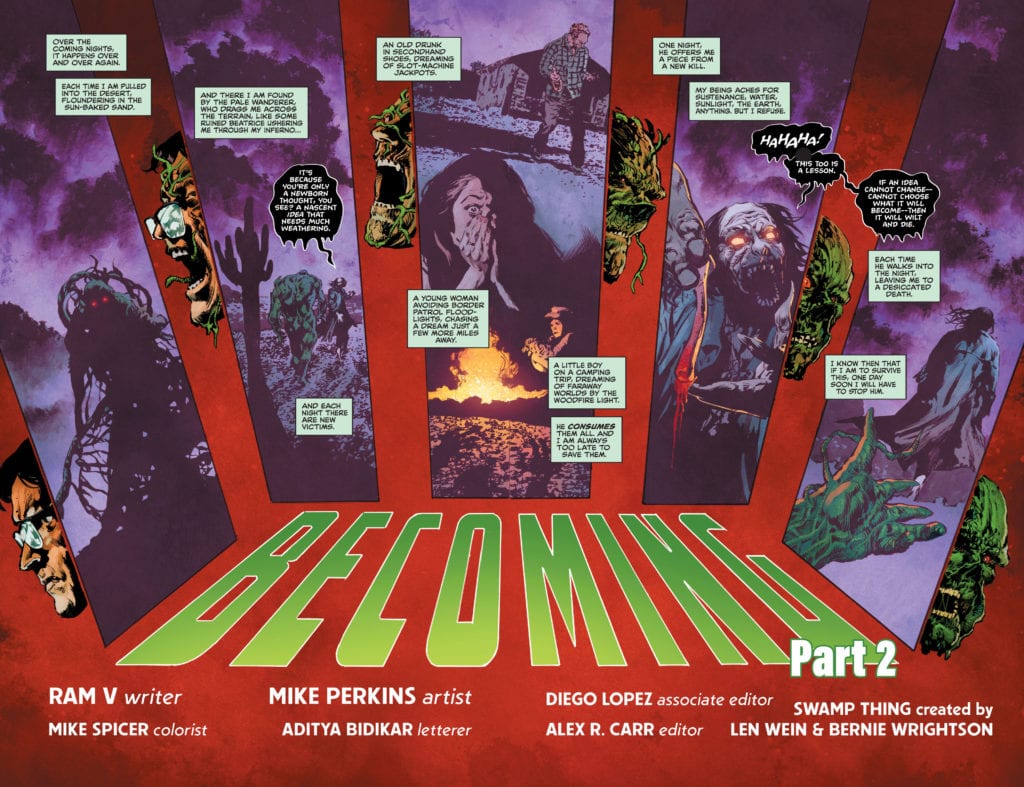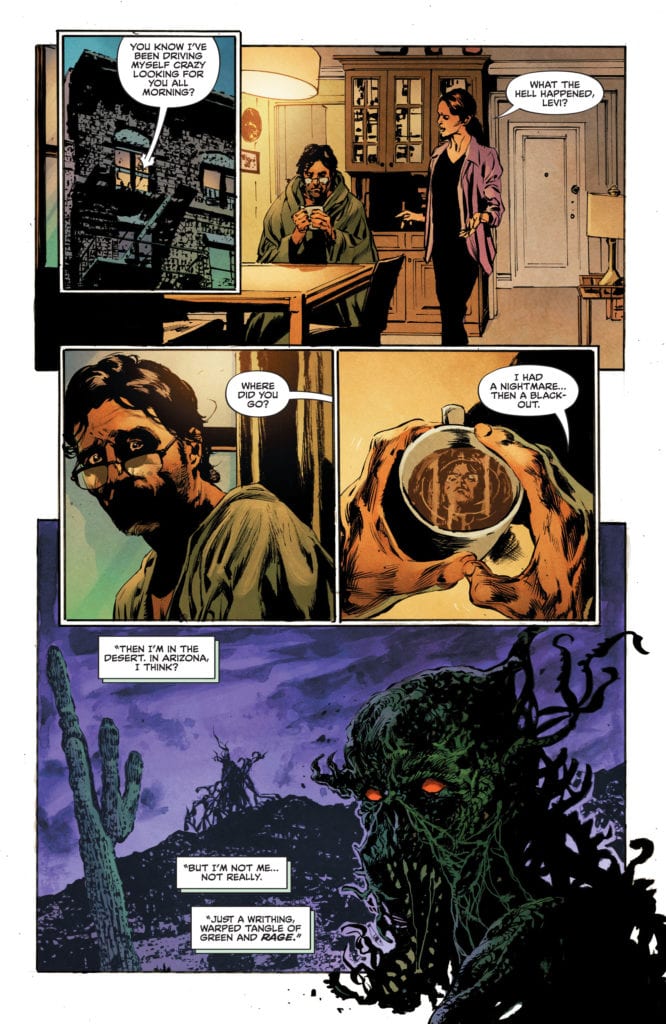DC Comics’ latest The Swamp Thing series is beautiful. Both in its visual beauty— every page and panel is breathtaking— and in its mysterious, quiet writing. Part of what made the first issue of this series so brilliant was how this creative team threw off the burden of continuing Swamp Thing’s existing stories. They weren’t going to be telling a story about Alec Holland. This brave, new direction, with a mysterious new Swamp Thing, was fantastic. But writer Ram V, artist Mike Perkins, colorist Mike Spicer, and letterer Aditya Bidikar stumble in their second issue. While they may have put aside the contents of previous Swamp Thing comics, The Swamp Thing #2 stylistically still operates in its predecessors’ shadows.
Writing
V has a brilliant narrative voice. He can really paint a picture. So much of these first few pages are spent doing just that. V describes Levi’s dreams in detail, giving the desert a mystical beauty. It’s all a little familiar, though. In fact, it’s even familiar for this character. It’s a style that feels borrowed from Alan Moore’s own work on Swamp Thing. This would be perfectly fine if V’s narration stopped at the captions. Unfortunately, much of the dialogue feels the same. It’s quite stilted. The Pale Wanderer and Swamp Thing talk as though they are just extensions of V’s own omniscient voice. And they talk in overly dramatic metaphors, with few true character moments that interrupt what feels more like preaching at one another. V’s knack for poetic writing actually does him a disservice here. His characters feel just a little too eloquent, and the discussions they have feel dry.

It really does feel as though V is seeking out a Moore’s Swamp Thing-esque voice. But, in modern comics, that voice feels a little dated. After all, those comics were written in the 80’s. And V’s move in that direction undoes some of the beautiful work he did in the first issue. It strips away some of the mystery, reduces characters to ideas rather than human beings. It robs his story of its humanity. Not only is V an eloquent writer, but he’s proven to be capable of writing heartbreaking character moments. Hopefully, we see him move back in that direction in the issues to come.
Art
Perkins brings in a lot of the lacking humanity to the story. Even in the rather big moments, Perkins still keeps us remembering that the characters are human. The Pale Wanderer refers to himself as an idea. In his dialogue, he literally dehumanizes himself. Yet when Perkins draws him, we somehow feel the Pale Wanderer is wrong. He does look human. We can see the fear under the anger, the trepidation under the cruelty. But one of the characters that really does feel human, the sheriff, is given quite a different treatment. Perkins shows the sheriff with shadows over his face. His eyes are rarely open, and when they are, they’re squinting and hard to see. His jaw is set, his face is emotionless. This is all coupled with a sad summary of the sheriff’s life. Perkins does a beautiful job of playing against each moment. He shows us glimpses of the humanity of those that deny it’s there, and he shows us the tough exterior of characters whose hearts are breaking.
Coloring
Spicer’s coloring is gorgeous. He uses a repetition of green, orange, purple and pink throughout. Many of the darker moments of the story have a tinge of purple or pink to them. These are most often the scenes that feature the Pale Wanderer. But there’s a peacefulness to the scenes too. Though the Pale Wanderer is killing and causing havoc, the scenes are almost comfortable. In one scene, the sheriff describes the hopelessness of his life. He sits in a bar with bright pink neon signs casting their light over the scene. Again, it’s a dark moment that looks beautiful. It’s as if Spicer is suggesting that despair isn’t as horrifying, at first glance, as we might like to think. In fact, it’s a comfortable place to be, and it lures us in with its subtlety.

Lettering
One of the greatest pieces of Bidikar’s lettering is found in how they connect some of the characters’ dialogue. Many of the characters have lots to say to one another. Bidikar could deliver each of their lines in one big chunk and lose all sense of rhythm, or they could stack word balloons on top of each other, dividing up each speech. Bidikar does stack word balloons, but they go a step further. Beyond just splitting the dialogue up, Bidikar actually creates space between thoughts. The sheriff gives us a speech about his bum liver and son who won’t talk to him. It’s all in one chunk. But then, when he follows up with, “I saw him, Emmet. I know he’s out there,” Bidikar places that line a half-inch away from everything else. We can hear the pause, the subtext of how these thoughts connect to one another. Bidikar shows us how the sheriff doesn’t rush through this, and it gives this moment of dialogue lots of weight.
V and Perkins’ The Swamp Thing is doing a lot right. But it’s stepping on its own toes in some ways. Its strengths lie in that it doesn’t try and be a Swamp Thing that everyone is familiar with. This isn’t Alec Holland; it’s Levi Kamei. But the creative team backtracks a little on that. They go in a new direction while also using narrative choices from past runs, choices that don’t quite jive with their story. However, there’s still lots to be excited about, and the end of this issue suggests V is already starting a new chapter in his approach. Pick up The Swamp Thing #2, out from DC Comics on April 6th, at a comic shop near you!

